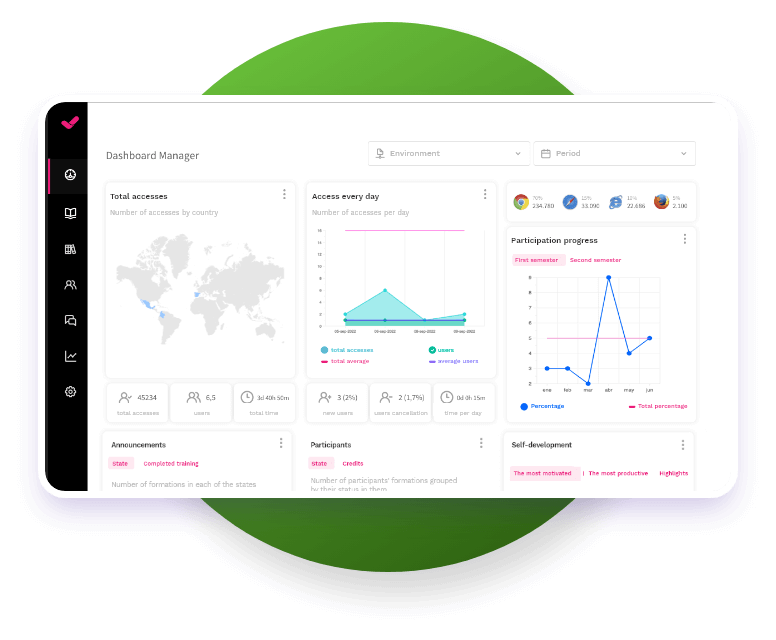Table of contents
ToggleThe sudden onset of the pandemic in 2020 triggered a significant paradigm shift in corporate training needs, forcing companies to design new training strategies in response. Since then, L&D departments have concentrated on implementing an array of technological changes to ensure that training programs meet the needs of this new era. One of the biggest challenges of this process is designing training suitable for remote workers and hybrid workforces.
And, although there is no magic formula for success, there are some key elements that are common to all good training programs. Want to know what they are? In this post, we’ll discover what training programs are, how to design them, and take a look at the best options for your company’s corporate training.
What is a training program?
Before examining how to make a successful training program, it’s important to understand exactly what it entails. A training program, simply put, is a plan designed to offer employees opportunities for professional growth and development.
Different companies will develop their programs with different courses and activities, according to the specific skills and knowledge needs of their staff. This allows each organization to increase the efficiency and productivity of its employees.
What are the benefits of a training program for your company?
When designed correctly, a corporate training program can offer all kinds of benefits to both your organization and its employees. Not only can it improve results and productivity, but also enhance a company’s culture, promote better talent retention, and increase overall job satisfaction. However, it also has many additional benefits:
- It gives value to employees, particularly through programs that focus on improving their performance – which, in turn, multiplies their chances of achieving the company’s objectives.
- Stimulates the exchange of knowledge, improving collaboration and communication.
- Promotes innovation and adaptation to change.
- Aligns employees with the organization’s objectives.
- Sharpens the company’s competitive advantage.
- Reduces costs and ensures that content is kept up-to-date.
- Offers employees geographic independence.
- Allows you to generate accessible versions of existing content.
What are the key elements of a successful training program?
Training programs offer advantages at every level of a company, but it is necessary to take into account certain variables to ensure that they function smoothly and effectively:
1. Effective program management
All successful training begins with appointing a qualified leader to manage the program. This person will hold the key responsibility of planning and executing the company’s training strategies, so they must be prepared for the task, bringing skills such as motivation, interest, commercial acumen and problem solving to the table.
Additionally, the leader will need to promote the training program internally to employees, so they must be able to effectively communicate the development opportunities it offers. Finally, they must be truly committed to improving their own skills and competencies, since this will enable them to better help others to do so.
2. Assessment of employee learning needs
Ensuring that you fill any existing skills gaps within the company will be vital to the success of the program, but before you get to work, you’ll need to identify those gaps. How can you do this?
In order to determine which section of the workforce needs training – and in what skills – you can use resources such as internal surveys, evaluations or interviews.
An LMS platform can also help you identify pressing training requirements, as some feature a personalized learning interface based on the behaviors of the platform’s users. This allows you to collect valuable information that can help you direct your efforts.
3. Alignment of training with company objectives
Once you have identified learning needs, it’s time to ensure that they are aligned with the organization’s objectives. The training manager must therefore create a learning plan that addresses and supports these goals.
Remember that any training courses offered to employees must aim to link the skills they learn to the company’s wider strategy, and must also offer measurable results in terms of productivity.
4. Training model
There is no better or worse model for training. The most appropriate will always be the one that best matches the needs and objectives of your company and its employees. Beyond purely in-person models, there are two broad types:
- Online: Workers study in a fully virtual learning environment.
- Hidrid or blended learning: Couples online training with in-person training.
However, you can go one step further than this, and facilitate training through mobile devices with a microlearning platform. Microlearning consists of offering concise micro-doses of training, easy to digest and absorb, and which can be consumed at any time and place.
5. Assessment of training
Consistent measurement of training results is necessary if you want to know that you’re going in the right direction. You can measure the effectiveness of training with four parameters:
- Employee feedback: Did they perceive the training they received as valuable?
- Level of learning: Do employees master the skills and principles they learned in training?
- Changes in behavior: Do employees apply the skills and techniques picked up during training to their daily tasks?
- Impact on the company: Were the training objectives achieved?
Successful training provides tangible results that can be reliably measured. These can be observed, for example, in reducing customer complaints, reducing the rejection rate, minimizing staff turnover or improving productivity.
6. Relevant training content
Providing relevant training content is key to ensuring effective employee training. At the beginning of the program, it’s important to give an overview of the content that will be presented. This should be done using concepts and terms that students can recognize, and by organizing the material into a clear and consistent structure to help them in their daily tasks.
7. Creative ideas that engage employees
Any corporate training program that offers creative, engaging and relevant courses has a better chance of being successful. In this respect, e-learning is a highly valuable method that companies are increasingly relying upon, because it offers the opportunity to create training courses using interactive resources such as videos, simulations, webinars, exercises and games.
8. Promotion of the training plan among employees
A popular training program is supported by an effective internal marketing strategy that not only informs employees of the program’s launch activities, but also explains the reasoning behind the training.
What do employees get from this training? And how could it help them grow professionally? Answering these questions will allow you to use marketing techniques to promote the training – not only when it is first announced, but also throughout its duration.
9. Reinforcement of training to heighten learning retention
Companies that invest a lot of money into training their employees, without reinforcing this learning, are wasting resources – and condemning the strategy to failure. Reinforcement activities in training are crucial to ensure that knowledge is applied on a daily basis, and that concepts learned are not forgotten.
A good way to achieve this is through using exercises and gamification in e-learning courses to reinforce learning. If you want to easily create impactful courses with plenty of reinforcement activities, you can count on an authoring tool like isEazy Author, which allows you to create dynamic, entertaining games and exercises in a matter of seconds.
10. Consistent course updates
Even if the training program has been a success, it is vital to keep it constantly updated. This will ensure that employees are better prepared for the challenges that can arise on a day-to-day basis.
This issue can easily be addressed with the right authoring tool. For example, isEazy Author allows you both to create and update e-learning courses in an agile, intuitive way.
11. Investment in innovative training technologies
Today, there are many technological solutions on the market to multiply the engagement and results of your training programs, such as isEazy Engage.
isEazy Engage is a training app containing everything your employees need to do their job better – especially frontline workers. With this cutting-edge app, your employees will have training, communication, documentation and task management features at their fingertips. Use it to take your training program to another level!
The top 7 types of corporate training program
Although, as we’ve seen, training needs are often specific to each individual company, changes in the labor landscape over recent years, as well as the digital transformation of work spaces, have highlighted an urgent need to update the skills and competencies of professionals across the board. In fact, the total number of skills required to perform a single job is increasing on average by 5.4% each year.
Thankfully, isEazy Skills offers the most complete skills catalog for training your team. Below, we present a list of the best corporate training programs you can offer your employees, and how to achieve it with isEazy Skills:
1. Team building development programs
Corporate training programs for the development of team building promote healthy social relationships within a company. This type of training helps professionals to develop skills that improve communication, collaboration, and even productivity within a team. They are also effective in improving job satisfaction, reducing employee turnover, and fostering greater team cohesion.
Just some of the corporate training courses isEazy Skills offers to help you promote team building include:
- Communicating assertively
- Improve the effectiveness of your communication
- Team building: take advantage of your team’s synergies
- Building a high-performance team
- Perfect your empathic listening
2. Leadership and high-performance team development programs
In any work environment, there is naturally a leader who is responsible for directing his or her team efficiently. However, leading not only involves good management skills, but also several other abilities, including: knowing how to adapt to different professional profiles, good communication, and the ability to motivate, supervise and guide.
In addition to learning how to enhance their talent, professionals who develop leadership and management skills also learn how to help that of their collaborators. They understand how to transform a simple group of professionals into a high-performance team, and are trained to construct a working environment that encourages innovation and the achievement of goals.
Over 26% of isEazy Skills users have successfully developed their power skills through corporate training courses in this field. Some of the most popular include:
- How to be a good leader
- How to boost your team’s motivation
- Leading efficient virtual meetings
- Involve and delegate – the key tools of a leader
- Effective supervision: the definitive key to guaranteeing results
3. Sustainability and diversity development programs
Sustainability and diversity are currently in high demand as development areas, as companies face the ongoing challenge of making their corporate culture more committed to people, the environment and, above all, inclusivity.
For Generation Z and millennials, protecting the environment is a priority. In fact, a Deloitte report revealed that both generations would like their companies and employers to make greater efforts to offer training programs related to environmental decision-making.
And when it comes to diversity, only 17% of millennials are satisfied with the efforts their companies make to create more diverse and inclusive spaces, compared to 34% of generation Z.
To make improvements in this area, companies must ensure that they offer training in fields such as: gender equality; poverty reduction; clean, affordable energy; and reducing inequality. To help with this, isEazy Skills offers you a great range of courses:
- Intergenerational leadership
- Managing diversity in your work environment
- Female empowerment
- How to apply Sustainable
- Development Goals in your daily life
- Promoting gender equality in your environment
4. Digital skills development programs
It’s a fact that, today, professionals must be able to adapt to change and use technology efficiently at work. Having digital mindset skills means having an open and curious mentality towards technology, and being willing to learn and experiment with new digital tools.
The development of digital skills is now, more than ever, a requirement for professionals, who must learn to manage new technologies and adjust their processes within the digital environment. Some of the most popular corporate training courses that isEazy Skills offer in this area include:
- The element of surprise in your virtual presentations
- Perfecting your written digital communication
- Organize your time effectively
- Big Data
- User Story Mapping
5. Business development and customer experience programs
Business development and customer experience programs aim to improve an organization’s ability to interact with its customers and increase sales effectively. This type of program develops employee skills through the implementation of efficient learning strategies that demonstrate best practices in sales and customer service.
The main objective of business development and customer experience programs is to enhance customer satisfaction, as well as the company’s relationship with those customers. To achieve these aims, the program may include a variety of courses. isEazy Skills’ most popular courses in this field include:
- How to overcome difficult situations with clients
- Creating value for your internal and external clients
- How to define and implement your commercial strategy
- Communication and commercial influence
- Building customer loyalty with excellent service
6. Emotional intelligence development programs
One way to predict the success of an organization is by measuring the emotional state of its employees. Increasingly, companies are aware of the importance of taking measures to help employees recognize and manage their emotions. This is typically achieved through programs that test an employee’s ability to handle stressful or complex situations, since this often separates them from their professional goals and the wider objectives of the organization.
Corporate training programs that nurture emotional skills in their employees produce better, more emotionally intelligent leaders who are aware, collaborative, and can more easily identify triggers that could affect their performance.
Some of the most popular courses at isEazy Skills to help with training in this area include:
- Emotional self-control: the key to your well-being
- How to develop your emotional intelligence
- Transforming stress and frustration
- Self-motivation: the secret of successful people
- Boost your optimistic outlook to simplify your life
7. Efficiency and productivity development programs
Behind any successful company is a team of productive and efficient professionals who focus on carrying out their duties, solving problems and improving their processes. Corporate training programs aimed at development in these areas teach employees to work effectively and consistently, and implement strategies to further improve performance and results.
Additionally, one of the resources that companies value most is time, and this is why teaching professionals how to manage it intelligently is vital to any training program. Some of the best courses for developing efficiency and productivity that isEazy has to offer are:
- Focus and say goodbye to distractions
- Making smart and effective decisions
- How to adapt to hybrid work
- Personal organization in digital environments
- Improve your professional image by enhancing your personal responsibility
E-learning trends to revolutionize your corporate training
In a field as rapidly shifting as e-learning, keeping up-to-date with the latest trends in the sector is essential. Some of the most important to emerge in recent years include:
X-learning: learning through experience
The rise of new technologies has caused many students to seek immediacy, and the personalization of information, when consuming content.
This trend is currently known as x-learning which, through the interface of an LXP (Learning Experience Platform), gives the user the chance to receive personalized training at any time and place.
Gamification: learning by playing
Gamification and e-learning complement each other remarkably well, and increasingly training platforms such as LMS include engaging recreational dynamics such as games, points, rankings, levels, etc., which make for a positive learning experience.
Social learning
Social learning is a new way to reinforce ideas, expand them, or refute them within a group of students, which generates learning opportunities like never before.
Through collaborative spaces such as forums, blogs or virtual classrooms, students can easily connect with their classmates, making them feel more involved in learning and developing a sense of belonging to their organization.
Artificial intelligence
The integration of artificial intelligence (AI) within companies is gaining ground, offering new ways of working with more efficiency and agility. Within the field of corporate training specifically, it presents the possibility of significant changes, particularly with regard to the generation of e-learning content.
In fact, isEazy Author is positioned as one of the first tools to include AI solutions, allowing content creators to multiply their productivity thanks to a host of features. These include: generating translations; voiceovers; subtitles; games; final evaluations; and even videos including avatars, all of which can be produced automatically and without leaving the tool.
Design your own training program with isEazy
With isEazy, you’ll have complete access to all the tools you need to develop your own successful training program.
Our authoring tool, isEazy Author, allows you to intuitively create interactive, accessible courses for your entire team through exercises, games, pre-configured interactive resources and much more! You can even customize your course content to match your stylebook.
And, if you prefer, we can produce your e-learning courses for you! With isEazy Factory, you can count on a team of over 50 designers to reduce your production time and costs. Likewise, you can also provide your employees with more than 540 soft skills and digital skills courses through isEazy Skills.
Discover all of our isEazy LMS, isEazy Engage, isEazy Game, and isEazy ESG solutions, and create a more attractive, effective training plan for your company. Make use of our technological tools, in combination or individually, to create high-impact training that meets your organization’s objectives. So what are you waiting for? Request your free trial today!


















